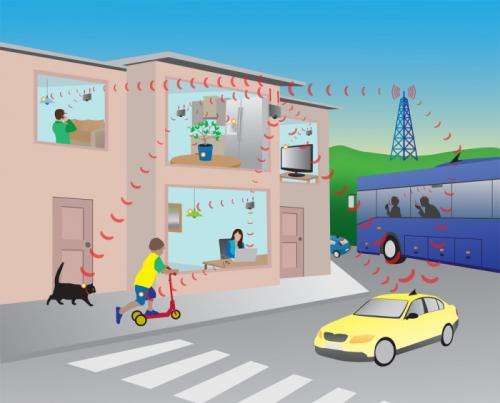Credit: Chalmers University of Technology
In a few years, our mobile network will have to deal with a thousand times more the traffic it has to today. One possible solution is to place small base stations in our homes or cars. This is one of several proposals being examined at Chalmers University of Technology, in the work being performed for the next generation wireless system – 5G.
The need to densify the cellular network will increase dramatically in the coming years. The sharp increase is driven by growth in smartphone subscriptions, and at the same time we are consuming more mobile services as an increasing number of services are made available. A very large number of new devices are also expected to communicate in the mobile network, in areas such as infotainment, transport and new industrial applications.
"We see that traffic capacity in the long term needs to increase a thousandfold to meet this rapid development. Theoretically, we could provide the capacity by increasing the number of big base stations, but this option is not economically viable," says Associate Professor Tommy Svensson at Chalmers University of Technology.
Chalmers is taking part in the 5G initiative Metis – the first international and large-scale research initiative on the 5th generation wireless systems. The Department of Signals and Systems is examining the possibility of densifying the cellular network by supplementing the infrastructure with simple, low power and small base stations. These can be positioned, for example, next to lampposts, facades and in indoor environments. Another proposal is to place small mobile base stations in vehicles, such as cars, trucks, buses and trains.
With these additions to the mobile network, data transfer from big base stations will become more efficient, and the distance to users will decrease – which will benefit high speed data traffic and result in increased battery life for mobile devices. When small base stations are located closer to users, radio signals can be used more efficiently and thereby be transmitted with less power, which means exposure to radiation from mobile communications can be reduced.
Placing base stations in vehicles can offer smart and flexible densification, which partially addresses the current problem of mobile access in crowded areas – where there are many people, there are generally also vehicles.
"Small mobile base stations can also contribute to secure communication between vehicles for traffic and road safety applications," says Professor Erik Ström at Chalmers University of Technology.
In fact, the future wireless network will form the foundation for an intelligent society where people and equipment can be connected anywhere, anytime – with anything. A high degree of connectivity will be a key enabler for new innovative technologies and applications that can benefit from information sharing. Achieving this within an integrated wireless network is a complex challenge for 5G.
"The combination of large and small base stations, and possibly direct communication between devices, can be integrated in different ways. We need to find a well-functioning system design with high reliability, very fast response times, user-friendly solutions and with low cost and low power consumption," says Tommy Svensson.
Prediction of mobile traffic
The number of smartphone subscriptions in 2012: 1.2 billion
The number of smartphone subscriptions in 2018: 4.5 billion
Mobile data traffic doubled between Q1 2012 and Q1 2013.
Mobile data traffic is expected to be 12 times higher by the end of 2018.
Five scenarios for 5G
The following 5G scenarios reflect the future challenges and will serve as guidance for further work.
1. "Amazingly fast", focusing on high data rates for future mobile broadband users;
2. "Great service in a crowd", focusing on mobile broadband access even in very crowded areas and conditions;
3. "Ubiquitous things communicating", focusing on efficient handling of a very large number of devices with widely varying requirements;
4. "Best experience follows you", focusing on delivering high levels of user experience to mobile end users; and
5. "Super real-time and reliable connections", focusing on new applications and use cases with stringent requirements for latency and reliability.
Six challenging requirements
Metis has derived a challenging set of requirements from these scenarios, which can be summarized as:
1. Ten to one hundred times higher typical user data rate where in a dense urban environment, the typical user data rate will range from one to ten Gbps;
2. One thousand times more mobile data per area (per user) where the volume per area (per user) will be over 100 Gbps/km2 (resp. 500 Gbyte/user/month);
3. Ten to one hundred times more connected devices;
4. Ten times longer battery life for low-power massive machine communications where machines such as sensors or pagers will have a battery life of a decade;
5. Support of ultra-fast application response times (e.g. for tactile Internet) where the end-to-end latency will be less than 5 ms with high reliability; and
6. A key challenge will be to fulfill the previous requirements under a similar cost and energy dissipation per area as that in today's cellular systems.
More information: www.metis2020.com/
Provided by Chalmers University of Technology























